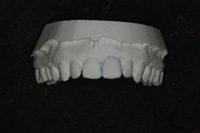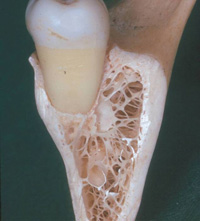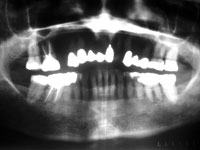If dentists were educated about the commitment needed to be a good team leader and staff manager before enrolling in dental school, and the frustrations and stress this responsibility entails, the majority, I think, would not sign on to be a dentist.
Dentists, understandably, want to be just that…dentists. My opinion…honestly? Many dentists quietly wish staff members would just turn up and do their jobs, allowing dentists to focus on doing what they like doing best…being a dentist.
When referring to staff management in my coaching programs, as in the business world, I use the term HR management (human resources). Staff is the most important resource, and the most expensive, within a dental practice or any business. HR management issues, while very complex, neatly fall into 3 specific areas:
• attract ’em….
• keep ’em….
• take care of problems when small, thus preventing problems from becoming bigger!
 |
|
Photograph by Brian C. Green
|
ATTRACTING AND HIRING THE DREAM TEAM
This is broken down into 3 key components:
• Planning–advertising your needs…your success is defined by your preparation.
• Holding interviews–the more you learn, the greater chance of finding the right one.
• Closing out–you’ve made your choice; your success is defined by how you support it.
In this article, we are going to focus on how to plan, write, and use an advertisement effectively for a vacancy in a dental office. It is a 12-step program.
STEP 1. DEFINE THE JOB RESPONSIBILITIES
There are 2 important reasons why it is essential to analyze exactly what the job opening entails.
(1) The first one obviously is to ensure that the “copy” accurately describes the practice needs. Therefore, this is an excellent time to update the team’s job descriptions to ensure that no responsibilities are falling between the cracks. (This project should be performed semi-annually.)
(2) Legally, an employer must be careful not to hire staff members who are actually underqualified for the advertised position. Firing an employee shortly after hiring because he or she was found not to have the needed skills and experience required for that position leaves the employer legally vulnerable. The employer is seen as guilty of placing the new employee in a position that guaranteed failure. An employer can be open to a claim for hiring above the capabilities of an applicant.
Both to protect yourself and also work toward finding the best person for the position, you need to take a 3-part approach to the hiring process. First, fully understand the skill set of the position; second, accurately describe those skills in the advertisement; and third, in the interview and hiring process, honor those delineated skill sets in making your short list and final choice of candidates. Even if this were not a legal consideration, it is a logical and commonsense approach to successful hiring.
STEP 2. BEFORE WRITING THE COPY, READ YOUR COMPETITION’S ADS
One of the management tips for successful hiring is to keep a record of both wonderful and awful ads you see in newspapers. Each weekend, take a few minutes to cull the current crop of ads both locally and when you travel. When you sit down to compose your ad, use a published ad you approve of and adapt it to meet your standards and needs. You don’t need to reinvent the wheel. Keeping a supply of really poorly written ads will give you confidence in your final product.
The quality and size of newspapers and their advertising costs vary widely across the country. Metropolitan papers provide a clear demarcation in their classified ad sections, grouping similar ads together, making it much more user friendly. In smaller publications this service is not provided, thus the dental ads are scat-tered throughout the classified section.
STEP 3. COMPOSE THE ADVERTISEMENT FROM THE READER’S PERSPECTIVE
In my opinion, this is the primary area where the majority of practices drop the ball. In my travels, I always make a point to pick up local papers to study the dental want-ads. I never cease to be surprised at the wide variety in the quality of the published ads. Maybe about 10% do an absolutely wonderful job, and the other 90% range from OK, to good, to actually…pretty bad. As our patient communication requires us to present information to patients from their perspective, so it is with designing vacancy positions. In other words…what’s in it for the reader?
 |
|
Figure 1. Sample classified ad for administrative staff. |
A well-written ad has 2 specific sections: the first one describes practice needs, and the second tells the reader what the applicant gains in return for bringing the listed skills to the table (Figure 1).
Let’s dissect the key words and analyze what the doctor was trying to convey.
(1) Modern denotes that the equipment and facility are up to date and the doctor has kept up with new techniques.
(2) Progressive informs the reader that this doctor is open-minded (unlike perhaps some other doctors in town!). The doctor and staff take CE courses; thinking is cutting- edge, on top of new things.
(3) Appreciates is used for a very specific reason, to let applicants know the business owner understands that appreciation is the primary need of employees, according to HR published surveys.
(4) Solid experience conveys that the doctor has chosen not to make a commitment to take an inexperienced person and invest in a long training program. Don’t call unless you genuinely can back up the application with a proven history in these areas as listed.
(5) Scheduling, making financial arrangements, etc (define the specific job responsibilities) states the position’s key responsibilities and experience required.
(6) Handling the telephone in a professional yet caring manner means that customer experience/service is as important as the dental experience requirement.
(7) We need you on our team is a short phrase that tells the reader 3 specific things:
•We–this is a practice where the doctor feels inclusive with the staff.
•Need you–an emotional phrase bringing energy and passion to the ad.
•On our team–magic words to the reader, this practice has structure, a leader, and a group of people who work together rather than as individuals.
(8) We are happy to offer up to $xx if qualified. Over the years my thinking has completely changed on this issue. When I came into dentistry and advertised for staff for our practice, there were several reasons why it would never have entered my mind to print the amount of money we felt we were prepared to pay. My thinking was that by stating a dollar amount, only staff members who put money at the top of their list would be attracted to the practice…and of course, employers are not exactly excited to hire staff whose primary need in life is money! But then I was educated–by people who knew much more than I did at that point in my life–on the benefits of listing wages/salaries…and I did a 180° turn. From a management perspective, it conveys 2 key pieces of information to the reader:
• The employer has figured out that good staff members deserve a good compensation plan, and
• If you feel you have the potential of reaching the job requirements in time, but honestly know you are not there yet, you can still apply for the position knowing that in this business, when staff members attain the highest level of professional service, top dollar is paid.
Today, it would never enter my mind not to list a financial figure as long as the following criteria are met:
• Your figure must be at, or above, the marketplace in your area.
• You must work on the assumption that your current staff members read the want-ads every weekend.
• Financial compensation must be stated in a legally correct manner so it does not come back to “bite you.”
 |
|
Figure 2. Sample classified ad for clinical staff. |
Please note that this ad carries no abbreviations. There is no kind way of saying this statement: abbreviations equ-ate to cheapness. If this is the image you wish to convey, then certainly save the money by using abbreviations. (For a sample ad for a clinical staff position, see Figure 2.)
STEP 4. CHOICES SHOULD BE MADE REGARDING HOW APPLICANTS CONTACT YOU
There are pluses and minus-es to each of the following methods, a subject for another article:
•telephone
•answering machine/voice mail
•fax
•Web site
•drop off resume
Eight more decisions must now be made before placing the ad.
STEP 5. ANALYZE YOUR PAST APPLICANTS’ RESUMES TO SEE IF YOU ALREADY HAVE A QUALIFIED PERSON ON FILE
Perhaps you offered the job to someone previously who was exactly the ideal person, but circumstances outside her control prevented her from taking the job. Never overlook your past applicants. Legally, you need to keep the resumes and applications on file for one year. I kept mine forever. It was amazing how often an applicant, whom you had actually told that the job had been offered to someone else, will reapply to your practice repeatedly. Forearmed is forewarned.
STEP 6. LOOK WITHIN YOUR CURRENT STAFF TO SEE IF IT IS POSSIBLE TO PROMOTE FROM WITHIN
This is an issue that needs to be addressed. If you have a clinical employee who has made it very clear she wishes to move to the business area, then you need to sit down with her and either offer the employee the job or explain why she is key in her present position in the clinical area, and advise her you will be placing an ad this coming weekend to fill an administrative position. Be proactive, not reactive, in your communication and management.
STEP 7. DECIDE HOW YOU PLAN TO INFORM/INVOLVE
Your Staff
I think dentists forget that the majority of staff read the weekend classifieds. Even happy staff!
STEP 8. DO YOU WANT TO ASK STAFF MEMBERS IF THEY KNOW OF POTENTIAL APPLICANTS?
There are pluses and minuses to bringing in friends of current staff. The biggest plus is that you save time, and the employee referring his or her friend or relative makes an amazing commitment to train the new employee. The big-gest downside is that when you have a problem with an employee who chooses to leave (or is terminated), he or she may take the friend or relative referred to you as well. In a small practice, this can be devastating.
STEP 9. WHO IS RESPONSIBLE FOR HANDLING THE INITIAL INFLUX OF RESUMES AND MAKING THE FIRST CONTACT?
This is such an important issue, and space does not permit us this month to expand on the pros and cons of who handles the incoming applications/resumes and how. This is key to successful hiring.
STEP 10. SCHEDULE QUALITY TIME TO SCHEDULE THE INITIAL AND FOLLOW-UP INTERVIEWS.
Ideally, if quality applicants do respond, I would like to see the decision made within days of the ad appearing. If you are not attracting likely candidates, then the goal is to adjust your schedule when you sense you do have a likely candidate so that you do not lose him or her because of your time constraints.
STEP 11. FORMS AND TECHNIQUES ARE UP-TO-DATE, AND LEGAL CONSIDERATIONS ARE CURRENT
To be able to process applicants in a timely manner, it is imperative that one does not waste time thinking about how one is going to handle the interview.
STEP 12. COMMIT TO NO COMPROMISING OR RUSHING, WHICH WILL SABOTAGE THE PROCESS
As in life, always shoot for the ideal applicant, then compromise, never the other way around.
THREE KEY POINTS FOR YOUR CONSIDERATION
(1) Who is your target? When you are composing the ad, mentally see the ideal applicant as the reader. You have 2 different audiences in the workplace:
•The unemployed, out-of-work person who has just left or been fired from a position, or has been taking time off. Either way, he or she is currently unemployed, needs a paycheck, and may be in need of a job immediately. So, the applicant has a vested interest in how he or she answers your interview questions. This is not the ideal candidate you are looking for.
•This person is a qualified candidate, maybe just what you are looking for, but is currently employed in another office…but feeling unhappy and unappreciated…and reads the want-ads each weekend. The applicant is in no rush, doesn’t want to make another mistake, and is taking quality time to find the perfect place. This is your candidate…this is the person you want to reach. Each word of your ad is carefully scrutinized by this type of candidate, and mentioning serious money tells the person you are serious about quality staff.
(2) Employers need to hire to their limitations not their strengths. If an employer is a perfectionist, therefore with the middle name “procrastinator,” and hires perfectionist-type staff, this ensures the practice will flounder in perfectionism paralysis. Such an employer would be better served to hire staff members who make decisions within their job responsibilities, move things along, and get things done. However, the perfectionist employer (include me here), on reading the previous sentence, actually feels his or her blood pressure rising…as they feel the control slipping out of their fingers (a subject for another article).
(3) Hire outside dentistry for administrative positions. I am a fan of this hiring thinking. The 6 key areas are hotels, banks, restaurants, travel agents, airlines, and retail. What do they all have in common? Customer service training and experience. It is so simple to teach nondental administrative staff members enough dentistry so that they meet 2 criteria: they know more about dentistry than the patients, and they can schedule from a logical perspective. Some of the happiest dentists I have met over the years have followed my advice and gone to the customer service industries. My favorite story is of a dentist in Toronto who, during my HR program, looked outside the window to the Four Seasons hotel across the square. At the end of the program, he walked across the street and hired the concierge. He has kept in touch and tells me repeatedly it was the best decision he ever made.
CONCLUSION
I know many dentists who have staff members where, quite honestly, it would be better for all parties if the staff member was working somewhere else. Change is very hard, especially for dentists, most of whom do not have the leadership/team management skills to address these types of situations. As dentists have told me over the years, “The devil that I know is most probably better than the one that I don’t know.” Or, as a dentist told me one day when I visited his office, and Attila the Hun (his receptionist) was on the phone, “Jenny, I know that you are right, but I don’t have the time to address the issue, and I have learned to work around her.” My answer was, “I do understand. That is your choice, as long as you realize that the patients’ idea of having to work around her is to move to another practice.” I am happy to report that he did address the issue. Instead of it being a quiet, professional outcome, though, his frustrations had been bottled up for so long that when the crisis occurred, he overreacted, and it was not a pleasant experience for anyone.
Doctors, please take the quality time either to learn or work with someone who can offer support, so that you are making wise staff decisions that will impact your health and welfare for years to come.
Ms. de St. Georges is one of dentistry’s most experienced and effective management consultants. Her unique philosophies have successfully been implemented in thousands of practices both nationwide and internationally. She is also a popular lecturer, published author, and contributing editor. To receive a complimentary copy of her Telephone Pre-Screening form and her Tip Sheet for Effective Initial Interview Scheduling, visit JdSG International’s Web site, AskJennyforHelp.com. For additional information, call (800) 366-7004.











